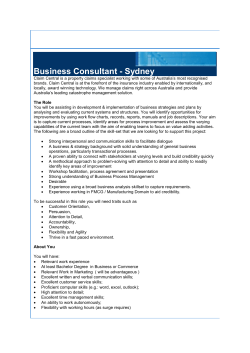
here. - OPEA
ASSOCIATION NEWS OPEA NEWS Words // OUTDOOR POWER EQUIPMENT ASSOCIATION Small Engine emissions standards move a step closer. E nvironment Minister Greg Hunt announced an Agreement between the state and federal ministers that will see emissions standards for outdoor power equipment on the table by mid-2015. According to the Ministers’ announcement, “Governments will complete work by mid-2015 to develop emissions control measures for: non-road spark ignition engines and equipment” (non-road spark ignition engines will include all petrol engines from lawn mowers to generators). “We welcome the business certainty that engine emissions standards are now on a timetable,” said OPEA President Gareth Taylor. Congratulating the Minister he added, “Greg Hunt is providing direction and is keeping to his schedule. “Standards have been in the pipeline since the Minister’s decision last April,” added Gareth. “This announcement is on schedule, and we can be confident that the standards will be posted by mid-2015. After that, it will still take a few months to draft the laws and put them in place.” Perhaps the last non-compliant engines will be delivered for Christmas this year, but it is more likely that “D-day” will be some time in 2016. After that date only engines that meet the new standard will be imported. Australia will probably match the USA EPA standard, meaning what is sold in the world’s largest outdoor power equipment market will pass muster in Australia, and without costly re-testing. Manufacturers won’t need more time: it is existing technology and already accounts for half the retail sales in Australia. The products that will be sold after the standards are in place are basically the 40 www.trademags.com.au/oed higher quality compliant products on the market now, according to Robert Baker, Brand Compliance Manager at Stihl. Most of these should be recognised by their USA EPA or EU compliance label. Most four-stoke engines pass, as do the higher end compliant two strokes. The regulations will also mean changes for manufacturers in Australia. Not only will their engines have to comply, fuel systems will need to limit the evaporative emissions. That starts with low permeation fuel lines, and on large equipment may include fuel tank expansion capacity and even a carbon canister on the fuel vent line. OPEA will prepare an information program to assist manufacturers to understand the proposed changes, so they can start to incorporate them into their designs. The harmful emissions targeted by the proposed regulations are Hydrocarbons, Oxides of Nitrogen, and Carbon Monoxide. All of these have serious health implications. Australia is 14 years behind the USA in implementing emission standards for non-road engines. We lag Canada, Europe, and Japan and are about two years behind China. For more information please visit www.opea.org.au OED
© Copyright 2025











